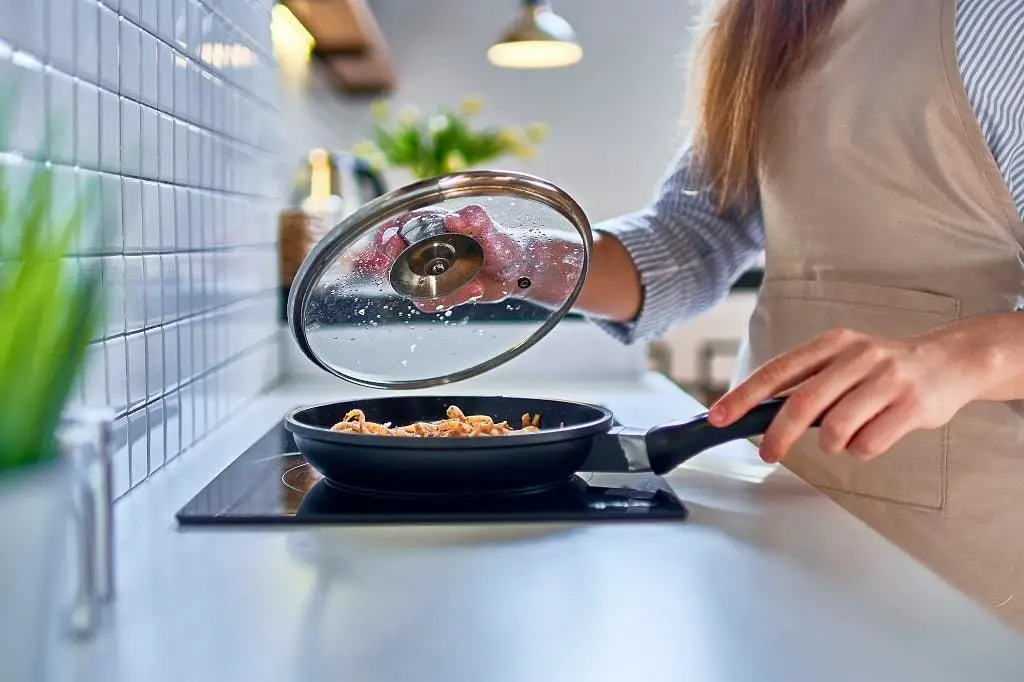This post contains affiliate links. When you buy through our links, we may earn a commission.
When you talk about ceramic and non-stick cookware, the features which come to your mind are durability, resistivity, and life span. Both can be differentiated by considering these features.
To properly differentiate, you should have some information about the structuring and manufacturing features of both the cookware.
Ceramic VS non stick cookware
Let us 1st talk about ceramic cookware:
Ceramic was not introduced centuries ago. It was introduced in recent years, but it has revolutionized the cookware world. Ceramic cookware is an eco-friendly product because it is not coated with chemicals like PFOA and PTFE.

Ceramic has revolutionized the cookware industry by introducing non-stick features. Non-stick ceramic cookware is coated with silicon dioxide and oleophobic & hydrophobic resistive chemicals. Coating of these resistors makes ceramic, oil and water-repellent cookware. In this way, the food you cook in ceramic does not stick with the bottom and sides of the ceramic pan.
Non-stick cookware is also known as Teflon. It is coated with PTFE (polytetrafluoroethylene). Non-stick also has resistive properties but recently, some of the hazardous health issues are being discussed by researchers.
There has been a discussion about non-stick pots emerged in recent years that at high temperature the coating of PTFE starts peeling off and get mixed with the food you cook.
The toxic ingredients of PTFE, are considered carcinogens (cancer causing agents), chemically contaminate the food. So, the coating of non-stick with PTFE makes it health hazardous.
The high-temperature resistivity feature of ceramic gets dominated as the PTFE coating of non-stick cookware is only stable in solid form at low temperatures.
But the discussion about the utility of the best kitchen utensils has always been rolling on the table. There are many other types of cookware available in the market. But ceramic and non-stick cookware has always been in market demand.
Let us navigate some questions which are frequently asked by the user about the compatibility, safety, and quality of ceramic and non-stick cookware.
Is non-stick ceramic cookware safe?
Yes, non-stick ceramic is non-toxic. It is safe to use in the kitchen. There are many manufacturers of non-stick ceramic cookware. The ceramic cookware, which is free from cadmium, lead, aluminum, PFAs, and PFOA coatings is considered 100% safe.
Ceramic is organic and is completely inert. It does not release any toxins like carcinogens. Non-stick ceramic is the best alternative to traditional non-stick cookware.
And if you are using the cookware which is constantly leaching away your health, you are rebellious of yourself.
Is ceramic cookware better than non-stick?
Yes, it is 100% guaranteed by researchers that ceramic cookware is far better than traditional non-stick cookware.
The temperature enduring capability of ceramic is stronger than non-stick. Ceramic is a perfect conductor of heat; it evenly heats the bottom of the pan and makes cooking easy and pleasant.
Another factor that makes the ceramic better than non-stick is that it is easy to wash and clean. Ceramic has a good capacity to store heat even after you remove the ceramic pan from the stove.
The more interesting feature is that ceramic is more non-stick than Teflon or, traditional, non-stick.
What type of non-stick cookware is best?
Having the right cooking pan makes cooking easy. For easy cooking purposes, non-stick cookware is proved advantageous.
Here is the list of some best known non-stick cookware:
- Anolon advanced home hard-anodized non-stick pan
- Anolon aluminum-based non-stick pans
- Ceramic coated non-stick
This non-stick cookware is considered best as compared to the non-stick coated with Teflon and PTFE or PFOA. Because Teflon releases toxic fumes.
Why do ceramic pans lose their non-stick?
When you expose your ceramic pan to high temperatures, it starts deteriorating its coating. This does not happen at once or after some time but losing the non-sticky feature of ceramic is a slow process.
Your ceramic pan can also lose its non-sticky due to the use of some hard utensils while stirring and cleaning. The coating of ceramic is of anodized- aluminum which makes it non-stick. But when you rub something hard in the pan, this layer gets peeled off.
What is the healthiest cookware to use?
Before using any kind of cookware in the kitchen, you should precisely know the risks and benefits of that utensil because this is a matter of your and your family’s health.
Following is the list of some safest non-stick cookware, which can be chosen safely regarding your health:
- Ceramic: it is a non-toxic, eco-friendly, and long-lasting cookware
- Aluminum: it is a good conductor of heat
- Copper: it is a conductor of heat and low-sticky
Using Teflon is hazardous to health because the toxins released from its coating can cause cancer and neurological problems.
Researchers have highlighted that Teflon is not to human health deteriorator but also hazardous to birds. There are reports issued that birds are dying of fumes coming from Teflon coated pans.
When should you throw away non-stick pans?
There is nothing forever. Everything has its life span. Non-stick cookware is not long-lasting. As it is coated with enamels of chemicals which start deteriorating after a period.
So, it is best to throw away non-stick pans after 5 years because due to continuous use of heating and warming, the coating deteriorates. It is wise to throw them away before their enamel gets mixed with your food.
What pans do chefs use?
Professional chefs are the ones who know better about culinary because they are most interested in making tasty food. The choice of cookware is a big deal while cooking tasty food.
Chefs mostly use pans with copper and ceramic coating for regular use. Because copper gets perfectly fit in the everyday usage featured cookware.
Chefs do not go for the aluminum coated pans because when you cook any acidic food in it, aluminum gets oxidized with the acid of food. They also recommend not to use Teflon coated non-stick pans.
What types of pans does Gordon Ramsay use?
Gordon Ramsay uses non-sticks pans free of PFOA. He uses a non-stick Scan Pan for frying purposes. Because it uses a little amount of oil and has a uniform heating bottom, which makes the food to be cooked evenly.
What is the healthiest non-stick pan?
From the above discussion, we get that ceramic non-stick pans are the best non-stick pans for daily kitchen use.
The healthiest ceramic pan is Greenspan Paris pro. Most of the ceramic pans lose non-sticky coating after some time or after regular usage. But Greenspan Paris pro ceramic cookware is scratch-resistor and is compatible even at 600 degrees, which makes it the healthiest ceramic non-stick pan.
Why does my ceramic frying pan stick?
There are many reasons behind loosening the non-stick coating of your frying pan.
The most common reason is the usage of hard and sharp utensils while scraping and stirring. This will make your pan’s coating to get loosed and the food will start sticking with the bottom of the pan.
How do you clean ceramic pans?
New ceramic pans should be washed with luke-warm water and then dried with a soft cloth. Avoid rubbing them with something hard and sharp.
The ceramic cookware, mostly, gets burnt while cooking on high flame. The easiest way to clean the ceramic pan is by using baking soda, hydrogen peroxide, and liquid soap.
Fill the pan with the liquid mixed with baking soda and hydrogen peroxide. Leave it for some time. And they wash it with liquid dishwashing soap.
How long do ceramic non-stick pans last?
Some good quality non-stick ceramic pans like Greenspan Paris pro last longer, about 5-6 years.
But most of the non-stick pans start loosening non-stick features after one year.
What is the least toxic cookware?
Ceramic cookware is the least toxic. Because it is made up of clay, heated at very high temperatures in the kiln. So ceramic pans are mostly free of toxins and heavy metals.
What is the healthiest material for pots and pans?
In the present age, the healthiest materials which can be used for the pans and pots are ceramic material which is made up of sand quartz at very high temperature baked in kilns. Other than this we can also go for stainless steel.
Is it bad to use aluminum cookware?
Aluminum has the potential to dissolve very easily and it mixes with the food if we continue cooking our food in the pans or pots and keep the food for aluminum in those pans, aluminum gets into our food. By some studies, it is believed that aluminum leads to Alzheimer’s disease.
What knives does Booby Flay use?
Booby Flays is highly inspired by the classic Western chef’s knives that are of Shun prepared in Japan.
Does the chef use non-stick pans?
Due to the delicacy of the non-stick pans, in many hotels and restaurants chefs do not use the nonstick pans. But few professional chefs go for the non-stick pans in the kitchens, particularly for the egg and fish dishes.
Do professional chefs use non-stick pans?
No, professional chefs do not use non-stick pans for daily kitchen use. The non-stick pans are fragile, slow to get heat up, and low retention capability.
That is why professional chefs rarely use non-stick pans.
But some professional chefs use non-stick pans only to fry eggs and warm up food.
Conclusion
This discussion has completely highlighted that ceramic is the better cookware for daily use rather than traditional non-stick cookware.
The most dominating features of ceramic cookware are:
- Sustained and highly enduring surface coating
- High heat retention and resistance
- Non-toxic and eco-friendly
